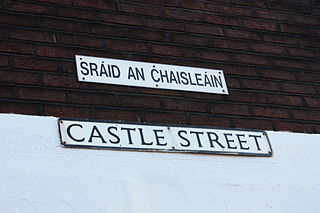Unless otherwise noted, statements in this article refer to Standard Finnish, which is based on the dialect spoken in the former Häme Province in central south Finland. Standard Finnish is used by professional speakers, such as reporters and news presenters on television.

Proto-Germanic is the reconstructed proto-language of the Germanic branch of the Indo-European languages.
Brithenig, or also known as Comroig, is an invented language, or constructed language ("conlang"). It was created as a hobby in 1996 by Andrew Smith from New Zealand, who also invented the alternate history of Ill Bethisad to "explain" it. Officially according to the Ill Bethisad Wiki, Brithenig is classified as a Britanno-Romance language, along with other Romance languages that displaced Celtic.
In linguistics, lenition is a sound change that alters consonants, making them more sonorous. The word lenition itself means "softening" or "weakening". Lenition can happen both synchronically and diachronically. Lenition can involve such changes as voicing a voiceless consonant, causing a consonant to relax occlusion, to lose its place of articulation, or even causing a consonant to disappear entirely.
The morphology of Irish is in some respects typical of an Indo-European language. Nouns are declined for number and case, and verbs for person and number. Nouns are classified by masculine or feminine gender. Other aspects of Irish morphology, while typical for an Insular Celtic language, are not typical for Indo-European, such as the presence of inflected prepositions and the initial consonant mutations. Irish syntax is also rather different from that of most Indo-European languages, due to its use of the verb–subject–object word order.
Consonant gradation is a type of consonant mutation found in some Uralic languages, more specifically in the Finnic, Samic and Samoyedic branches. It originally arose as an allophonic alternation between open and closed syllables, but has become grammaticalised due to changes in the syllable structure of the languages affected.

Northern or North Sámi is the most widely spoken of all Sámi languages. The area where Northern Sámi is spoken covers the northern parts of Norway, Sweden and Finland. The number of Northern Sámi speakers is estimated to be somewhere between 15,000 and 25,000. About 2,000 of these live in Finland and between 5,000 and 6,000 in Sweden, with the remaining portions being in Norway.
Consonant harmony is a type of "long-distance" phonological assimilation, akin to the similar assimilatory process involving vowels, i.e. vowel harmony.
Old Irish, also called Old Gaelic, is the oldest form of the Goidelic/Gaelic language for which there are extensive written texts. It was used from c. 600 to c. 900. The main contemporary texts are dated c. 700–850; by 900 the language had already transitioned into early Middle Irish. Some Old Irish texts date from the 10th century, although these are presumably copies of texts written at an earlier time. Old Irish is thus forebear to Modern Irish, Manx and Scottish Gaelic.

Irish, like all modern Celtic languages, is characterized by its initial consonant mutations. These mutations affect the initial consonant of a word under specific morphological and syntactic conditions. The mutations are an important tool in understanding the relationship between two words and can differentiate various meanings.
Compensatory lengthening in phonology and historical linguistics is the lengthening of a vowel sound that happens upon the loss of a following consonant, usually in the syllable coda, or of a vowel in an adjacent syllable. Lengthening triggered by consonant loss may be considered an extreme form of fusion. Both types may arise from speakers' attempts to preserve a word's moraic count.
Middle Welsh is the label attached to the Welsh language of the 12th to 15th centuries, of which much more remains than for any earlier period. This form of Welsh developed directly from Old Welsh.
In linguistics, apophony is any alternation within a word that indicates grammatical information.
The morphology of the Welsh language has many characteristics likely to be unfamiliar to speakers of English or continental European languages like French or German, but has much in common with the other modern Insular Celtic languages: Irish, Scottish Gaelic, Manx, Cornish, and Breton. Welsh is a moderately inflected language. Verbs inflect for person, number, tense, and mood, with affirmative, interrogative, and negative conjugations of some verbs. There is no case inflection in Modern Welsh.
The morphology of the Welsh language shows many characteristics perhaps unfamiliar to speakers of English or continental European languages like French or German, but has much in common with the other modern Insular Celtic languages: Irish, Scottish Gaelic, Manx, Cornish, and Breton. Welsh is a moderately inflected language. Verbs conjugate for person, tense and mood with affirmative, interrogative and negative conjugations of some verbs. A majority of prepositions inflect for person and number. There are few case inflections in Literary Welsh, being confined to certain pronouns.
Qaqet, or Baining, is a non-Austronesian language from the Baining family spoken in East New Britain Province on the island of New Britain, Papua New Guinea.
Proto-Finnic or Proto-Baltic-Finnic is the common ancestor of the Finnic languages, which include the national languages Finnish and Estonian. Proto-Finnic is not attested in any texts, but has been reconstructed by linguists. Proto-Finnic is itself descended ultimately from Proto-Uralic.
Consonant gradation is the term used for a systematic set of alternations which are widespread in Finnish grammar. These alternations are a form of synchronic lenition. They occur also in other Finnic and Uralic languages; see consonant gradation for a more general overview.
This article describes the grammar of the Old Irish language. The grammar of the language has been described with exhaustive detail by various authors, including Thurneysen, Binchy and Bergin, McCone, O'Connell, Stifter, among many others.
Old Irish was affected by a series of phonological changes that radically altered its appearance compared with Proto-Celtic and older Celtic languages. The changes occurred at a fairly rapid pace between 350 and 550 CE.


